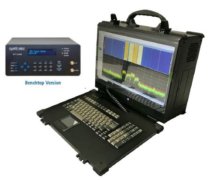These Real-Time Spectrum Analyzer solutions feature ultra-portable configurations for real-time, long-term recording of RF signals. Wideband signals up to 27 GHz can be viewed, analyzed, and recorded using system-based packages that weigh less than 5.4 kg to 10.8 kg. They can easily be transported on commercial airlines as carry-on luggage.
There are two primary configurations – The first one employs an ultra-portable measurement controller and an Ethernet connected tuner/digitizer/DDC processor. These 2 units weigh about 2.7 kg. each, for a total solution weight of 5.4 kg. Real-time signals up to 100 MHz bandwidth can be viewed, and time domain snapshots recorded and processed later on.
Other capabilities include broadband (up to 27 GHz) spectrum viewing, waterfall displays, frequency domain triggering, and signal averaging, with many cursor and display options.
Once a signal of interest is identified, users can switch to real-time recording mode. By using DDC to narrow the bandwidth, the system enables long term gap-free continuous recording of signals up to 2.5 MHz bandwidth – for durations up to 71 hours.
These recordings can then be played back and analyzed on the display, with signal regions extracted, saved, and converted to other file formats for further post processing on other systems.
The next level configuration, which add an external Thunderbolt hosted 16-Bit digitizer, can be purchased as a total solution to start, or optionally purchased as an upgrade to smaller configuration.
The Thunderbolt based 16-bit digitizer enables much wider bandwidth real-time recording. This adds about 5.4 kg for a still very portable 10.8 kg total solution.
All the capabilities described in the first configuration are still available. But now, the higher performance digitizer allows for real-time recordings up to 160 MHz in bandwidth, with selectable recorded bandwidths of 100, 80, 40, and 10 MHz, depending on configuration. With this solution, 160 MHz of bandwidth can be continuously recorder for up to 1 hour or 80 MHz of bandwidth can be continuously recorded for up to 2 hours.




